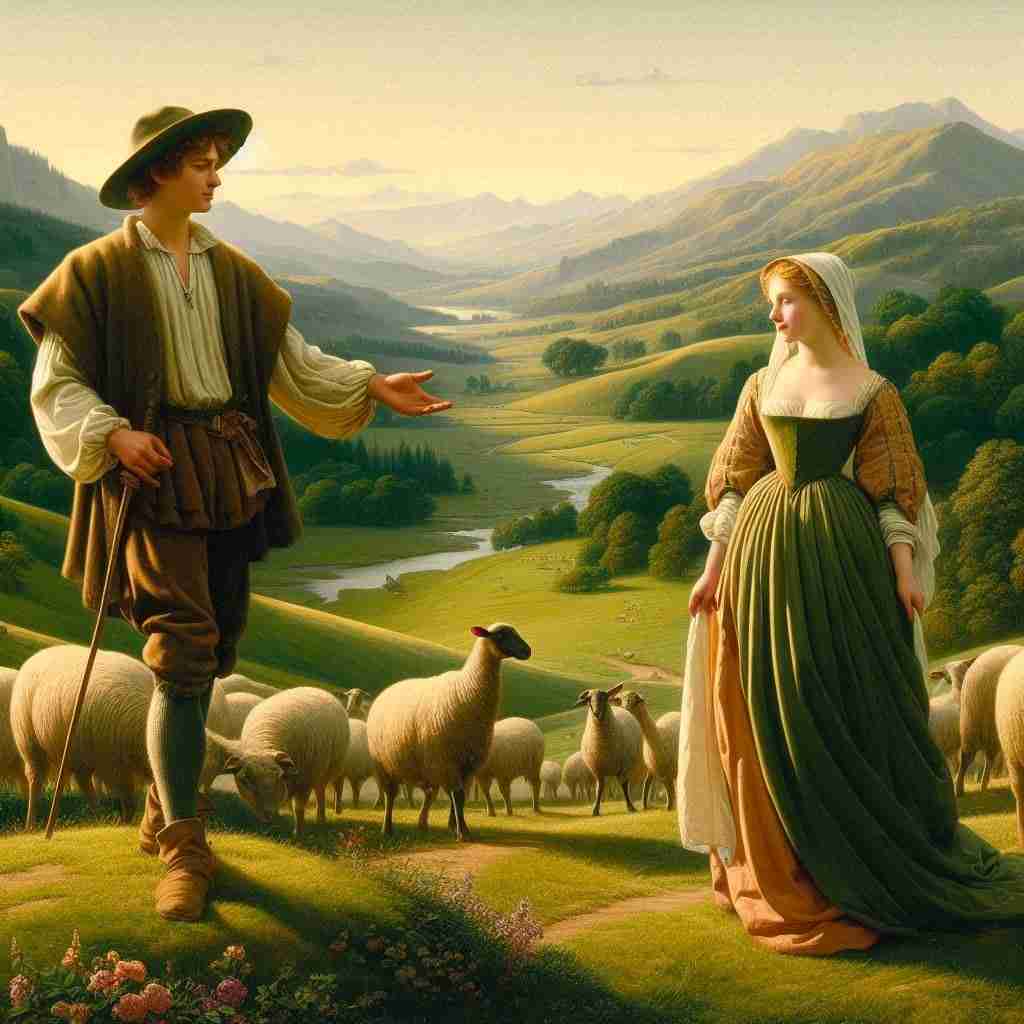The Passionate Shepherd to His Love
Christopher Marlowe
1564 to 1593

Want to track your favorites? Reopen or create a unique username. No personal details are required!
Come live with me and be my love,
And we will all the pleasures prove,
That Valleys, groves, hills, and fields,
Woods, or steepy mountain yields.
And we will sit upon the Rocks,
Seeing the Shepherds feed their flocks,
By shallow Rivers to whose falls
Melodious birds sing Madrigals.
And I will make thee beds of Roses
And a thousand fragrant posies,
A cap of flowers, and a kirtle
Embroidered all with leaves of Myrtle;
A gown made of the finest wool
Which from our pretty Lambs we pull;
Fair lined slippers for the cold,
With buckles of the purest gold;
A belt of straw and Ivy buds,
With Coral clasps and Amber studs:
And if these pleasures may thee move,
Come live with me, and be my love.
The Shepherds’ Swains shall dance and sing
For thy delight each May-morning:
If these delights thy mind may move,
Then live with me, and be my love.
Christopher Marlowe's The Passionate Shepherd to His Love
Christopher Marlowe's "The Passionate Shepherd to His Love" is a quintessential example of pastoral poetry from the English Renaissance. Composed in the late 16th century, this lyrical poem embodies the idealized vision of rural life that was popular in literature of the time. Through its vivid imagery, rhythmic structure, and romantic appeal, Marlowe creates a persuasive argument for a life of love in an idyllic natural setting.
The poem is structured as an invitation from the shepherd to his beloved, employing the rhetorical device of suasoria - a form of persuasive speech. This invitation is framed by the repeated refrain, "Come live with me and be my love," which appears in the opening line and is echoed with slight variations in the closing stanzas. This repetition serves to reinforce the shepherd's earnest plea and creates a sense of musical harmony that reflects the pastoral setting.
Marlowe's use of imagery is particularly striking throughout the poem. He paints a lush, sensory landscape that appeals to the reader's visual, auditory, and tactile senses. The natural world is presented as a bountiful provider, offering "all the pleasures" that "Valleys, groves, hills, and fields, / Woods, or steepy mountain yields." This depiction of nature as generous and accommodating is a hallmark of the pastoral tradition, presenting an idealized version of rural life that contrasts sharply with the often harsh realities of agricultural existence.
The poet employs a catalog of gifts and experiences to entice his love, each more elaborate than the last. From simple pleasures like watching shepherds and listening to birdsong, he progresses to promises of luxurious items: beds of roses, gowns of fine wool, and gold-buckled slippers. This escalation serves to emphasize the depth of the shepherd's devotion and his willingness to provide for his beloved. However, it also introduces a note of artifice into the natural setting, as many of these gifts require human craftsmanship to produce.
The juxtaposition of natural and artificial elements is a key aspect of the poem's complexity. While ostensibly celebrating the simple life, the shepherd promises items that would be more at home in a courtly setting. This blending of rustic and refined elements reflects the poem's position as a literary construct rather than a genuine representation of pastoral life. It also speaks to the tensions inherent in the Renaissance worldview, which sought to reconcile classical ideals with contemporary realities.
Marlowe's choice of language and meter contributes significantly to the poem's effect. The consistent iambic tetrameter creates a lilting, song-like quality that echoes the "Madrigals" mentioned in the text. This musical quality is enhanced by the rhyming couplets, which give the poem a sense of structure and harmony. The language itself is deceptively simple, relying on concrete nouns and active verbs to create a vivid, immediate sense of place and action.
Despite its surface simplicity, the poem invites deeper analysis. The shepherd's promises, while romantic, raise questions about the nature of love and the role of material goods in relationships. The emphasis on visual beauty and physical pleasures suggests a potentially superficial understanding of love, one that may not withstand the test of time or the harsh realities of rural life.
Furthermore, the poem's gender dynamics are worth examining. The male speaker's active role in making promises and the implicit passivity of the female beloved reflect the societal norms of Marlowe's time. This power imbalance is subtly reinforced through the shepherd's repeated use of "I will" statements, contrasted with the conditional "If these delights thy mind may move" addressed to his love.
In conclusion, "The Passionate Shepherd to His Love" is a masterful example of pastoral poetry that rewards close reading and analysis. Through its artful blend of natural imagery, romantic idealism, and subtle complexity, Marlowe creates a work that continues to captivate readers centuries after its composition. The poem's enduring appeal lies not only in its beautiful imagery and musical language but also in the questions it raises about love, nature, and human desire. As such, it remains a rich subject for literary study, offering insights into both the artistic conventions of its time and the timeless themes of human experience.
This text was generated by AI and is for reference only. Learn more

